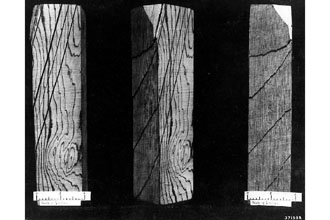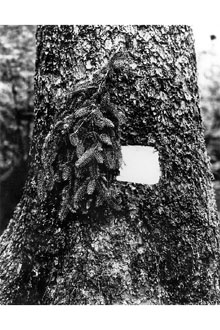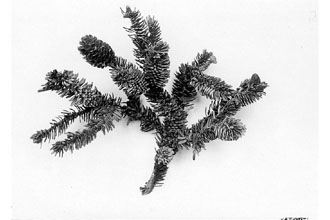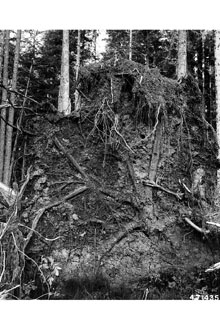Sitka Spruce
Scientific Name: Picea sitchensis (Bong.) Carrière
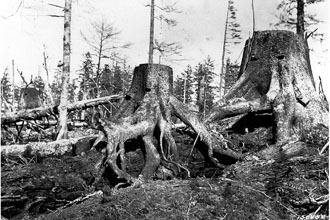
| General Information | |
|---|---|
| Usda Symbol | PISI |
| Group | Gymnosperm |
| Life Cycle | Perennial |
| Growth Habits | Tree |
| Native Locations | PISI |
Plant Guide
Alternative Names
sitka spur, coast west spruce, coast spruce, tideland spruce, yellow spruce, western spruce, silver spruce, menzies’ spruce
Uses
Ethnobotanic: The sharp needles of spruce were believed to have special powers for protection against evil thoughts (Pojar & MacKinnon 1994), The Ditidaht and other Nuu-chah-nulth peoples used the boughs in winter dance ceremonies to protect the dancers and scare spectators (Ibid,), The inner bark was eaten fresh, or dried into cakes and eaten with berries, It was also dried and grounded into a powder and used as a thickener in soups or added to cereals when making bread, The roots were burnt over an open fire to remove the bark, then dried and split to make hats and ropes (Moerman 1998), The roots were also used by several native North American tribes to make tightly woven baskets that would hold water (Lauriault 1989), A pitch obtained from the tree was used as glue or as a protective varnish-like coat on wood (Moerman 1998), Sitka spruce was widely employed medicinally by several native North American Indian tribes who used it especially for its antiseptic qualities in the treatment of lung complaints, sores and wounds (Moerman 1998), It has been chewed in the treatment of throat problems, coughs, and colds (Ibid,), Sitka spruce pitch was also used as a medicine for gonorrhea, syphilis, internal swelling, and toothaches (Pojar & MacKinnon 1994), A decoction of the roots has been used in the treatment of diarrhea, Economic: Sitka spruce produces high-grade lumber that is the most important wood for airplane and glider construction, In World War II, this wood was utilized in the British Mosquito bombers (Viereck & Little 1972), Other important uses are oars, ladders, scaffolding, and boats, particularly racing sculls (Ibid,), This wood is valued in making piano sounding boards and guitars, Use soil moisture sensors to measure the soil moisture of Sitka Spruce., It is harvested as saw timber and pulpwood and processed into lumber, plywood and various paper products, Charles Webber © California Academy of Science @ CalPhotos Landscaping & Wildlife: Sitka spruce is often planted as an ornamental tree in the eastern and northern states and in western and northern Europe (Sargent 1961), This forest species provides habitat for a large variety of mammals, reptiles, amphibians, and birds, It is browsed only in the spring by a variety of birds,
Status
Please consult the PLANTS Web site and your State Department of Natural Resources for this plant’s current status, such as, state noxious status and wetland indicator values.
Description
General: Spruce Family (Pinaceae). Sitka spruce is a large, native, evergreen tree that can grow up to two hundred feet in height. The needles are yellowish-green to bluish-green, stiff, very sharp, 1 to 1½ inches long, with white lines of stomata on the upper surface (Pojar & MacKinnon 1994). The cones are one to four inches long, hanging down, with very thin scales, rounded, and irregularly toothed. The bark is gray and smooth on small trunks, becoming dark purplish-brown on older trunks. Distribution: Sitka spruce is native to the Pacific Coast region from Alaska, to western British Columbia, Washington, Oregon, and northwestern California. For current distribution, please consult the Plant profile page for this species on the PLANTS Web site.
Adaptation
Picea sitchensis is often found on moist well-drained sites such as alluvial floodplains, marine terraces, and headlands (Pojar & MacKinnon 1994). This species prefers full sun and is intolerant of shade and atmospheric pollution. Sitka spruce grows in pure stands, more often mixed with western hemlock, Douglas fir, western redcedar, yellow cedar, grand fir, red alder, and black cottonwood (Farrar 1995).
Establishment
Propagation by Seed: Picea sitchensis seed requires no pretreatment if the seed is sown fresh, however a period of cold unifies and hastens germination (Dirr & Heuser 1987). Sow stored seeds as early in the year as possible. Preferably sow the seeds in a position in light shade. Seeds should be stored in a cool place and should not be allowed to dry out. Put seedlings into individual pots when they are large enough to handle and grow them in the greenhouse for the first winter. They can be planted into their permanent positions in early summer of the following year. Propagation by Cuttings: The cuttings, five to ten centimeters long, are cut in June with a heel of older wood, treated with 3000 ppm IBA-talc, and placed in sand without removal of the needles (Dirr & Heuser 1987). After rooting, the cuttings have one to two roots that should be pruned to stimulate lateral root development before transplanting to flats. Staking is also required to develop a symmetrical plant form (Ibid.).
Management
General: Sitka spruce prefers cool temperatures and moisture soil. Several times in the spring, pinch the new growth of young seedlings when shoots are about one inch long to check if watering is necessary. Major pruning should be done in the early fall and all the needles should never be removed. Cultivars, Improved and Selected Materials (and area of origin) Readily available through nurseries within its range. Contact your local Natural Resources
Conservation
Service (formerly Soil Conservation Service) office for more information. Look in the phone book under ”United States Government.” The Natural Resources Conservation Service will be listed under the subheading “Department of Agriculture.”
References
Britton, N.L. 1908. North American trees. Henry Holt & Company, New York, New York. Dirr, M.A. & C.W. Heuser, Jr. 1987. The reference manual of woody plant propagation: from seed to tissue culture. Varsity Press, Athens, Georgia. Farrar, J.L. 1995. Trees of the northern United States and Canada. Iowa State University Press, Ames, Iowa. Grimm, W.C. 1967. Familiar trees of America. Harper & Row, Publishers, New York, New York. Lauriault, J. 1989. Identification guide to the trees of Canada. Fitzhenry & Whiteside, Ontario, Canada. McMinn, H.E. & E. Maino 1963. An illustrated manual of pacific coast trees. University of California Press, Berkeley, California. Moerman, D. 1998. Native American ethnobotany. Timber Press, Oregon. Pojar, J & A. MacKinnon 1994. Plants of the pacific northwest coast: Washington, Oregon, British Columbia, and Alaska. Lone Pine Publishing, Redmond, Washington. Pratt, M.B. 1922. Shade and ornamental trees of California. California State Board of Forestry, California. Preston, R.J., Jr., 1989. North American trees. 4th ed. Iowa State University Press, Ames, Iowa. Rehder, A. 1990. Manual of cultivated trees and shrubs: hardy in North America. 2nd ed. Dioscorides Press, Portland, Oregon. Sargent, C.S. 1961. Manual of the trees of North America. Vol. 1. Dover Publications, Inc., New York, New York. Viereck, L.A. & E.L. Little, Jr. 1972. Alaska trees and shrubs. United States Department of Agriculture, Washington, D.C. Agriculture Handbook No. 410.
Plant Traits
Growth Requirements
| Temperature, Minimum (°F) | -33 |
|---|---|
| Adapted to Coarse Textured Soils | Yes |
| Adapted to Fine Textured Soils | No |
| Adapted to Medium Textured Soils | Yes |
| Anaerobic Tolerance | Low |
| CaCO3 Tolerance | Medium |
| Cold Stratification Required | No |
| Drought Tolerance | Low |
| Fertility Requirement | High |
| Fire Tolerance | None |
| Frost Free Days, Minimum | 111 |
| Hedge Tolerance | None |
| Moisture Use | Medium |
| pH, Maximum | 5.7 |
| pH, Minimum | 3.9 |
| Planting Density per Acre, Maxim | 700 |
| Planting Density per Acre, Minim | 300 |
| Precipitation, Maximum | 225 |
| Precipitation, Minimum | 22 |
| Root Depth, Minimum (inches) | 30 |
| Salinity Tolerance | None |
| Shade Tolerance | Tolerant |
Morphology/Physiology
| Bloat | None |
|---|---|
| Toxicity | None |
| Resprout Ability | No |
| Shape and Orientation | Conical |
| Active Growth Period | Spring and Summer |
| C:N Ratio | High |
| Coppice Potential | No |
| Fall Conspicuous | No |
| Fire Resistant | No |
| Flower Color | Yellow |
| Flower Conspicuous | No |
| Foliage Color | Green |
| Foliage Porosity Summer | Dense |
| Foliage Porosity Winter | Dense |
| Foliage Texture | Medium |
| Fruit/Seed Conspicuous | No |
| Nitrogen Fixation | None |
| Low Growing Grass | No |
| Lifespan | Long |
| Leaf Retention | Yes |
| Known Allelopath | No |
| Height, Mature (feet) | 200.0 |
| Height at 20 Years, Maximum (fee | 40 |
| Growth Rate | Moderate |
| Growth Form | Single Stem |
| Fruit/Seed Color | Brown |
Reproduction
| Vegetative Spread Rate | Slow |
|---|---|
| Small Grain | No |
| Seedling Vigor | Low |
| Seed Spread Rate | Slow |
| Fruit/Seed Period End | Fall |
| Seed per Pound | 209600 |
| Propagated by Tubers | No |
| Propagated by Sprigs | No |
| Propagated by Sod | No |
| Propagated by Seed | Yes |
| Propagated by Corm | No |
| Propagated by Container | Yes |
| Propagated by Bulb | No |
| Propagated by Bare Root | Yes |
| Fruit/Seed Persistence | Yes |
| Fruit/Seed Period Begin | Fall |
| Fruit/Seed Abundance | Medium |
| Commercial Availability | Routinely Available |
| Bloom Period | Late Spring |
| Propagated by Cuttings | Yes |
Suitability/Use
| Veneer Product | No |
|---|---|
| Pulpwood Product | Yes |
| Post Product | No |
| Palatable Human | No |
| Palatable Browse Animal | Low |
| Nursery Stock Product | No |
| Naval Store Product | Yes |
| Lumber Product | Yes |
| Fuelwood Product | Medium |
| Fodder Product | No |
| Christmas Tree Product | No |
| Berry/Nut/Seed Product | No |

